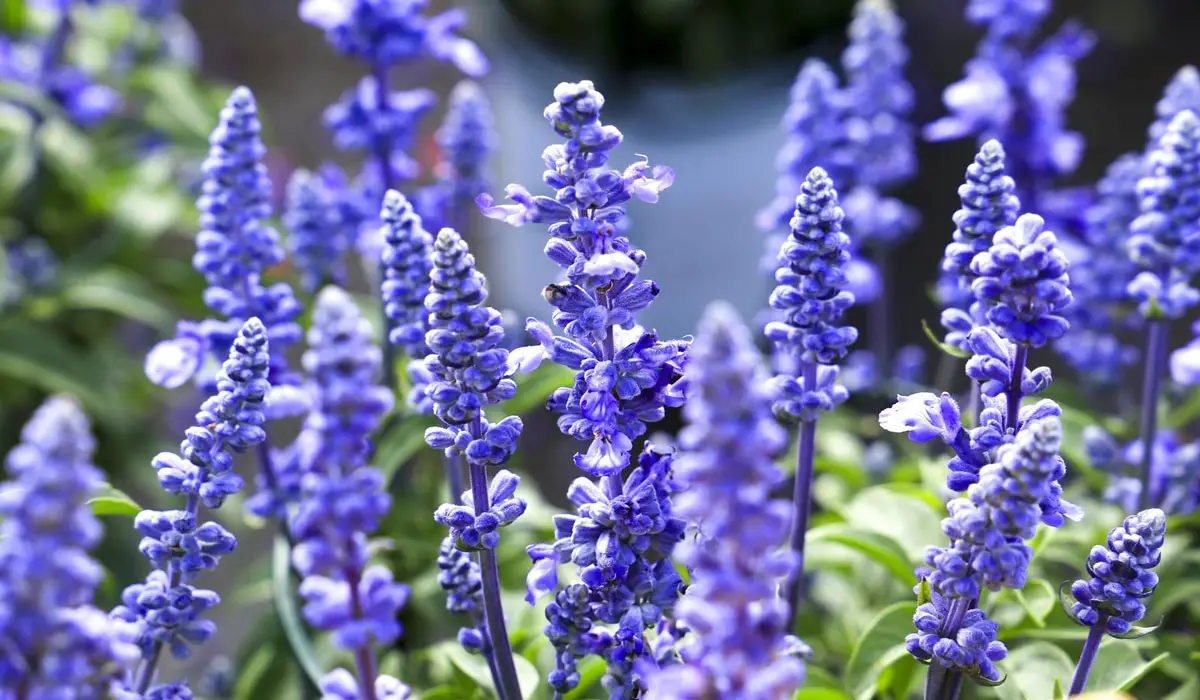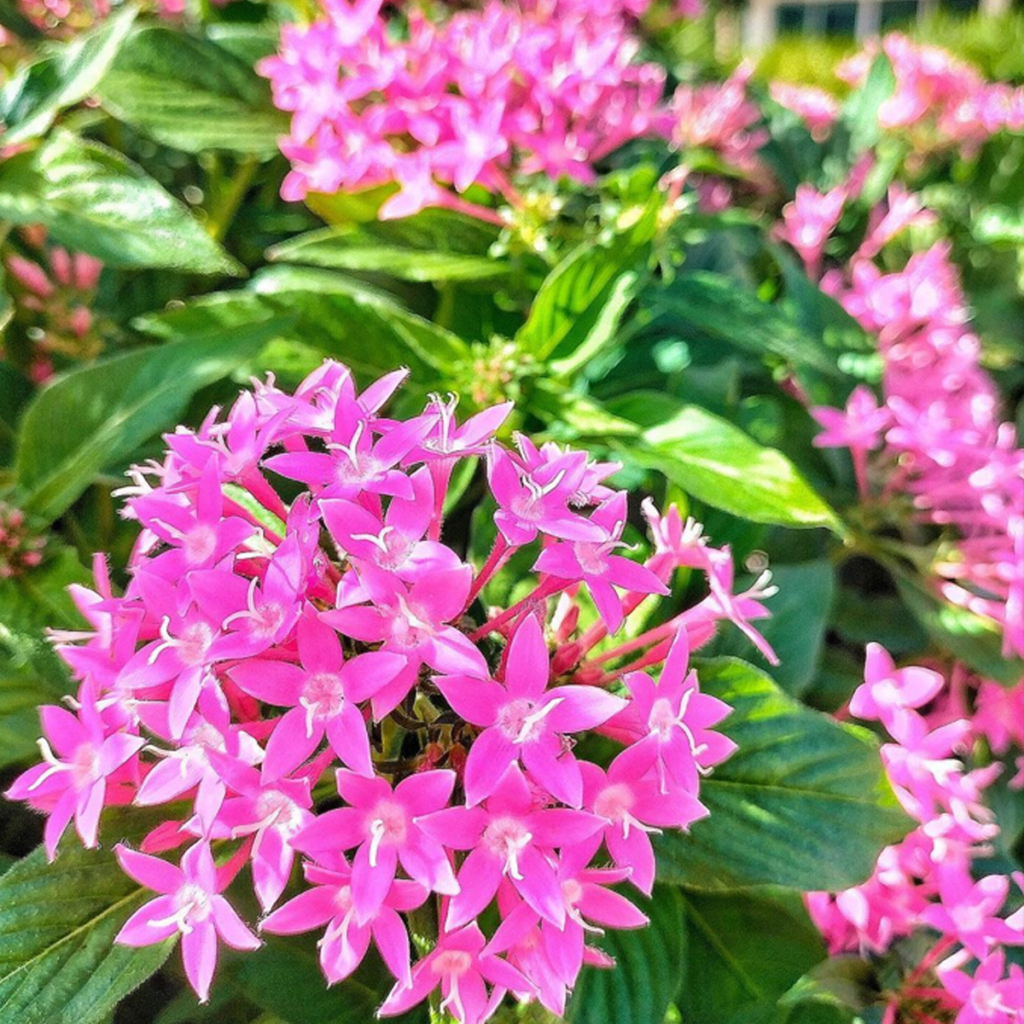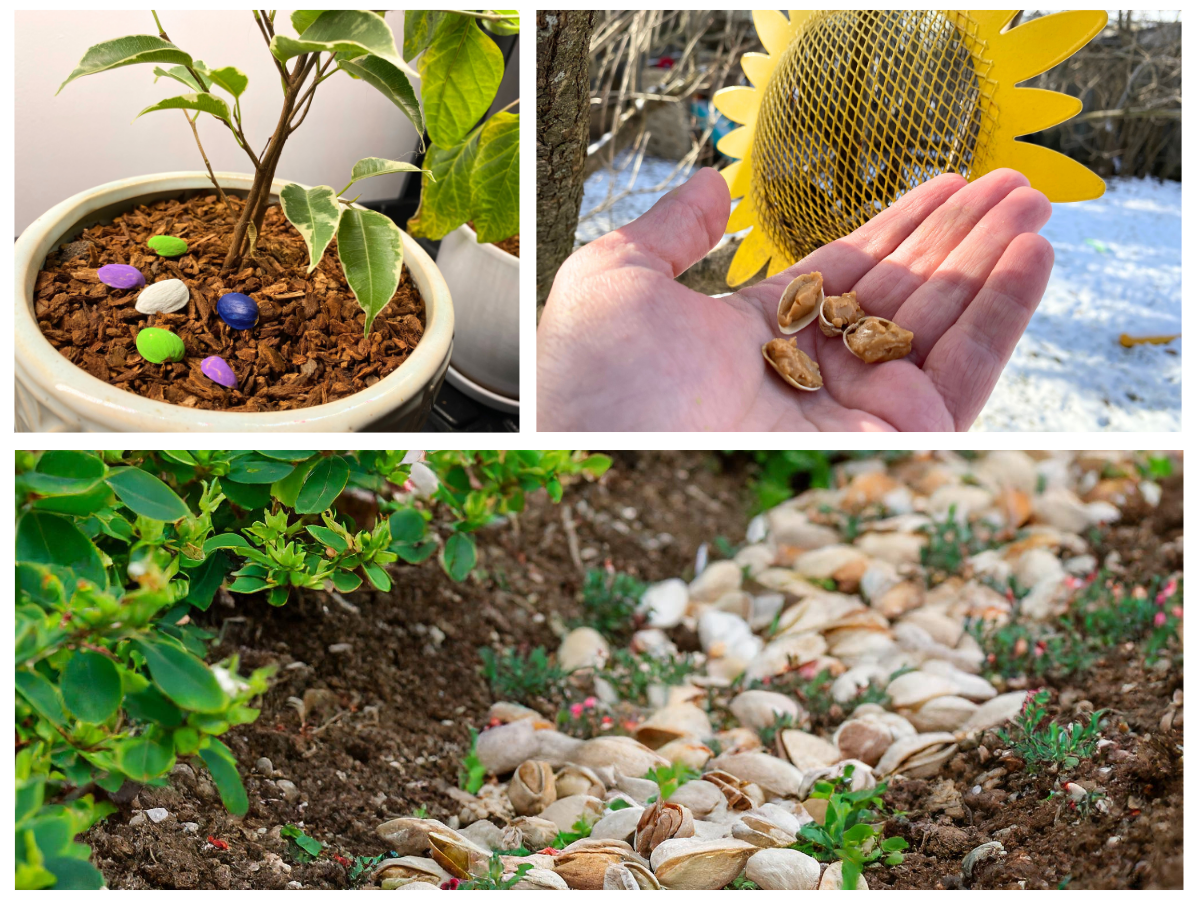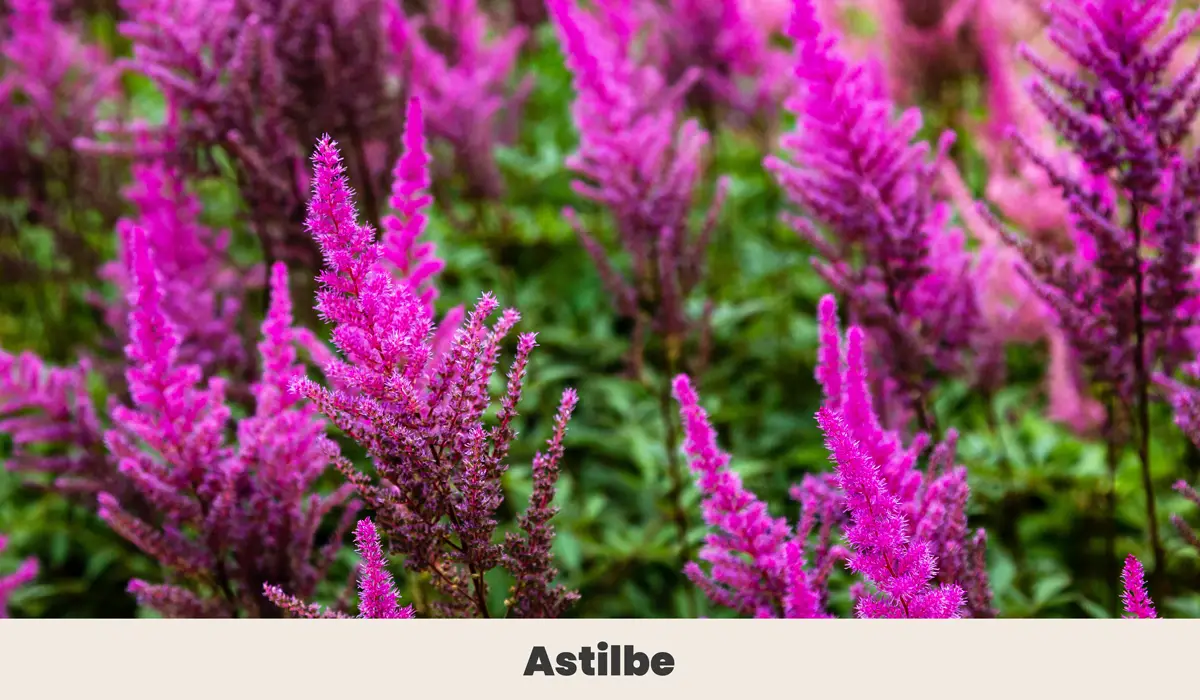9 Loved Plants That Look Like Lavender + Growing Guides

If you’re anything like me, then you love the benefits of growing lavender in your garden; it smells sweet, looks great, and comes back every year if properly cared for.
but, maybe you already have this wonderful flower growing in your garden and would like to complement it with other flowers that look like lavender. Or maybe you love the look but just can’t seem to grow lavender where you live and are on the hunt for similar flowers.

Luckily Lavender has plenty of lookalikes, almost as many flowers that look like daisies.
below, I go over my top list of flowers that look like lavender and why you should consider growing them in your garden. These plants are easy to grow, care for and are perfect for beginners.
Without further adieu, here are the top 9 most beloved plants that look like lavender you should add to your garden:
1. Purple Salvias (Salvia Nemorosa)

Are you looking for ways to insert a little more color into your garden? If so, you should consider Purple Salvias.
These long-stemmed plants grow up to 16” tall and have bright, vibrant purple flowers that are real show-stoppers.
They require little maintenance and thrive best when exposed to six hours of full sun and up to four hours of shade.
Here’s what you need to know about caring for these flowers that bloom all summer:
| Botanical Name: | Salvia Nemorosa |
| Growth Rate: | 14-16” tall and up to 20” wide |
| Native Range: | Asia and Europe |
| Hardiness Zones: | 3-8 |
| Dangers: | Non-toxic to the touch, can cause gastrointestinal issues if ingested |
| Soil Needs: | Fertile, well-draining soil |
| Exposure: | Partial-full sun, shade |
| Ease of Care: | Low-maintenance |
| Diseases: | Leaf spot, rust, powdery mildew, and botrytis |
| Propagation: | Divide stems in the spring |
| Fertilizer: | Apply |
| Pests: | Scale, thrips, whiteflies, and aphids |
| Blooming Period: | Spring-summer |
| Pruning: | Trim after new growth emerges |
| Water needs: | Water when the soil is dry to the touch |
2. Rosemary (Rosmarinus officinalis)

Are insects invading your garden? If you’re looking for a natural way to get rid of them, you should plant some Rosemary.
Rosemary is often used to naturally deter common pests including flies and mosquitos away from your garden, not to mention your backyard patio.
Plus, they make the perfect ground cover because they can adapt to any type of soil condition. Best of all, once in bloom, you can use Rosemary as a cooking herb.
Keep in mind that, even though Rosemary can be propagated by seed, “…this is not recommended because germination rates are very low and it takes up to three years to produce a bush sizable enough for harvesting.”
There are so many benefits to this plant, so if you’re eager to get started, here’s what you need to know about taking care of it:
| Botanical Name: | Rosmarinus officinalis |
| Growth Rate: | 2-6’ tall |
| Native Range: | The Mediterranean region |
| Hardiness Zones: | 8-11 |
| Dangers: | Non-toxic |
| Soil Needs: | Sandy, fertile, well-draining soil |
| Exposure: | Full sun |
| Ease of Care: | Low-maintenance |
| Diseases: | Root rot, powdery mildew, phytophthora root, crown rot |
| Propagation: | Propagate via cutting in either late spring or summer |
| Fertilizer: | Apply fertilizer in the spring |
| Pests: | Scale, aphids, whiteflies, spittlebugs, and spider mites |
| Blooming Period: | Spring – early summer |
| Pruning: | Cut back when it starts looking overgrown |
| Water needs: | Water when the soil completely dries out; generally drought-tolerant |
3. Holy Basil (Ocimum tenuiflorum)

Holy Basil is often used for medicinal purposes, however, if you plan on growing it in your garden, you can also use it for tea.
Holy Basil is part of the Mint family. This invasive shrub is easy to take care of, with the most work it requires being ongoing pruning.
This plant can grow very quickly, so you should start trimming it down the first month following planting.
Eager to add Holy Basil to your garden? Here’s a handy care guide:
| Botanical Name: | Ocimum tenuiflorum |
| Growth Rate: | 2’ tall and up to 2’ wide |
| Native Range: | Southeast Asia |
| Hardiness Zones: | 10b-11 |
| Dangers: | Non-toxic, but should be consumed carefully |
| Soil Needs: | Rich, well-draining loam |
| Exposure: | Partial to full sun |
| Ease of Care: | Low-maintenance |
| Diseases: | Basil downy mildew, powdery mildew, and root rot |
| Propagation: | Propagate with seeds 4-6 weeks before the first frost of the season |
| Fertilizer: | Not recommended, however, you can apply compost |
| Pests: | Whiteflies, aphids, and caterpillars |
| Blooming Period: | All year |
| Pruning: | Start pruning about a month after planting due to how fast it grows |
| Water needs: | Water enough to keep soil moist, but not soggy |
4. Russian Sage (Perovskia atriplicifolia)

Russian Sage is a real showstopper. With its tall stems and bushy purple blooms, it will immediately draw eyes to your garden – as well as bees and other pollinators.
In fact, Russian Safe is one of the best plants to cultivate if you’re looking to attract more bees to your garden due to its fragrant, lavender-like scent.
This plant can get pretty big, up to 5 feet tall and 4 feet wide, so be prepared for this to take up a lot of space.
It is a perennial, which means that, while it tends to have a shorter blooming period, it will regrow every spring.
Here’s what you need to know about caring for these beautiful, lavender-looking flowers:
| Botanical Name: | Perovskia atriplicifolia |
| Growth Rate: | up to 5’ tall and up to 4’ wide |
| Native Range: | Western China and the Himalayas |
| Hardiness Zones: | 5-9 |
| Dangers: | Non-toxic |
| Soil Needs: | Dry, well-draining soil |
| Exposure: | Full sun |
| Ease of Care: | Low-maintenance |
| Diseases: | Not applicable |
| Propagation: | Divide and propagate plant in the spring |
| Fertilizer: | Apply a 5-10-5 fertilizer when plant has been pruned to the ground |
| Pests: | Not applicable |
| Blooming Period: | Summer – fall |
| Pruning: | Cut plant to the ground in late winter and early spring when new growth emerges |
| Water needs: | Water during the growing season while roots are being established; drought-tolerant after that |
5. Hyssop (Hyssopus officinalis)

Like other plants mentioned on this list, Hyssop is a real visual stunner that makes a bold statement on your landscape, thanks to its tall purple blossoms.
These perennial shrubs are perfect for lining up against your fence or when used as a border. They usually give off a very fresh, woody scent to them.
The Hyssop plant also commonly attracts pollinators, like butterflies!
Hyssop is considered to be very low-maintenance, so it’s perfect for those that are just developing their green thumbs.
Here’s an easy overview for taking care of these plants if you’re looking to grow them this year:
| Botanical Name: | Hyssopus officinalis |
| Growth Rate: | Up to 2’ tall and up to 1.5’ wide |
| Native Range: | Europe, North Africa, and Asia |
| Hardiness Zones: | 4-9 |
| Dangers: | Can be toxic if ingested, especially by those who have epilepsy |
| Soil Needs: | Fertile, well-draining soil |
| Exposure: | Part shade – full sun |
| Ease of Care: | Low-maintenance |
| Diseases: | Powdery mildew and root rot |
| Propagation: | A fertile, well-draining soil |
| Fertilizer: | Not required |
| Pests: | Flea beetles, slugs, and cabbage maggots |
| Blooming Period: | Summer |
| Pruning: | Trim in early spring to encourage new growth |
| Water needs: | Divide the plant in the spring |
6. Catmint (Nepeta Mussinii)

Aside from having a fun and eclectic name, Catmint works just as well in a garden as it does being used for ground cover or as a border.
When in bloom, Catmint has small, eye-grabbing purple flowers that can be used for homemade tea.
Catmint is pretty easy to take care of, only requiring well-draining soil and a little bit of compost when first planted. While this isn’t necessary, doing so will make your Catmint plant fuller.
Here’s what you need to know about caring for Catmint at home:
| Botanical Name: | Nepeta Mussinii |
| Growth Rate: | Up tp 36” tall |
| Native Range: | Northern Iran |
| Hardiness Zones: | 4-8 |
| Dangers: | Non-toxic |
| Soil Needs: | Fertile, well-draining soil |
| Exposure: | Full sun |
| Ease of Care: | Low-maintenance |
| Diseases: | Septoria leaf spot |
| Propagation: | A fertile, well-draining soil |
| Fertilizer: | Not required, but compost is recommended |
| Pests: | Flea beetles and squash bugs |
| Blooming Period: | Early – late summer |
| Pruning: | Cut plants to the ground after their blooming period is over to encourage new growth |
| Water needs: | Divide the plant in the middle of summer |
7. Showy Hebe (Veronica speciosa)

Aesthetic-wise, the Showy Hebe is quite an interesting plant thanks to its textured, pine-cone-looking flowers.
Since it looks like a tropical flower, it’s the perfect plant to choose if you want to add a little bit of tropical flare to your garden.
Though the Showy Hebe is easy to care for, be mindful that it absolutely cannot grow in either full or partial shade. It needs full sun and moist soil to thrive.
If you’re interested in growing some Showy Hebe, here’s a helpful care guide to doing so:
| Botanical Name: | Veronica speciosa |
| Growth Rate: | Up to 5’ tall |
| Native Range: | New Zealand |
| Hardiness Zones: | 6-9 |
| Dangers: | Non-toxic |
| Soil Needs: | Well-draining, moist soil |
| Exposure: | Full sun |
| Ease of Care: | Low-maintenance |
| Diseases: | Sphaerotheca and powdery mildew |
| Propagation: | Divide plant while it’s dormant, either in early spring or autumn |
| Fertilizer: | Apply fertilizer every 14 days while growing |
| Pests: | Not applicable |
| Blooming Period: | Late spring – mid-summer |
| Pruning: | Prune in early spring, or deadhead when flowers start wilting |
| Water needs: | Water when soil is dry, every 3-4 days |
8. Anise Hyssop Blue Fortune (Agastache)

Also known as a Blue Fortune, these blue-purple-colored flowers are tall, sticky cones that commonly attract bees, butterflies, and hummingbirds.
Like the other plants on this list, the Anise Hyssop Blue Fortune is a low-maintenance plant, only requiring compost when first planted.
Once the root system is established, you can cease watering the plant because of its tolerance to droughts.
Here’s a helpful care guide:
| Botanical Name: | Agastache |
| Growth Rate: | 2-3’ tall and up to 24” wide |
| Native Range: | North America |
| Hardiness Zones: | 5-9 |
| Dangers: | Non-toxic |
| Soil Needs: | Dry, well-draining soil |
| Exposure: | Full sun |
| Ease of Care: | Low-maintenance |
| Diseases: | Powdery mildew |
| Propagation: | A dry, well-draining soil |
| Fertilizer: | Add compost when planted |
| Pests: | Not applicable |
| Blooming Period: | Middle of summer – early fall |
| Pruning: | Deadhead wilting flowers to encourage new growth |
| Water needs: | Water weekly the first month following planting, then they become drought-tolerant |
9. Purple Rain – Ornamental Onion (Allium × cristophii)

The Purple Rain – Ornamental Onion is one of the most interesting plants on this list due to their large circular shape.
While these do look similar to an onion, they get their name due to the scent they emit is similar to an onion.
When in bloom, these flowers can grow to be up to 36” tall and, if pruned regularly, will come back the following year.
If you plan on adding these to your garden, it’s recommended that you plant at least 15 of them because otherwise, they’ll be hard to miss.
Thinking of adding these to your garden? Here’s what you need to know:
| Botanical Name: | Allium × cristophii |
| Growth Rate: | Up to 36” tall |
| Native Range: | Middle East |
| Hardiness Zones: | 4-7 |
| Dangers: | Toxic to household pets, especially cats |
| Soil Needs: | Fertile, well-draining soil |
| Exposure: | Full sun |
| Ease of Care: | Low-maintenance |
| Diseases: | Downy mildew and onion white rot |
| Propagation: | Divide plant when the leaves have died, then plant on fresh compost |
| Fertilizer: | Apply a slow-release 10-10-10 fertilizer to established plants in the spring |
| Pests: | Slugs, onion flies, snails, and allium leaf mining fly |
| Blooming Period: | Late spring – early summer |
| Pruning: | Trim plant when leaves turn yellow |
| Water needs: | Water every 3-5 days, unless it is raining consistently |
Final Thoughts
Not only do all of the plants mentioned on this list have similar qualities to lavender, but they all can create a visually stunning garden that will attract the best pollinators to help everything else in your garden bloom.
With this helpful care guide, you can create a lavender-colored garden that will be easy to care for and will re-bloom the following year so you can enjoy them time and again.




